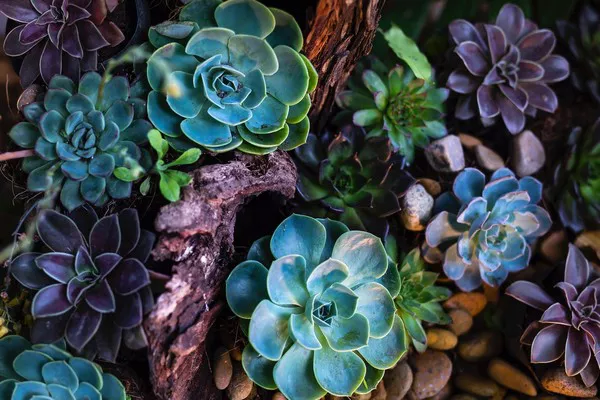Repotting succulents is a crucial aspect of their care routine, contributing to their overall health and well-being. While many succulent enthusiasts emphasize the importance of well-draining containers, there may be instances where you find yourself needing to repot succulents without drainage holes.
Selecting the Right Container
When repotting succulents without drainage, choosing the right container is paramount. Opt for a container with sufficient depth to accommodate the succulent’s root system while allowing space for a layer of well-draining soil. Containers made of materials like clay or terracotta can help absorb excess moisture, reducing the risk of overwatering. Ensure that the container has a wide opening to facilitate air circulation around the succulent.
Creating a Well-Draining Soil Mix
Compensating for the lack of drainage holes requires special attention to the soil mix. Create a well-draining soil mix by combining potting soil with materials like perlite, pumice, or coarse sand. The goal is to enhance the soil’s aeration and drainage properties, preventing waterlogged conditions that can be detrimental to succulents. Aim for a mix that allows water to move through the soil quickly, reducing the risk of root rot.
Monitoring Watering Practices
Repotting succulents without drainage necessitates a keen awareness of watering practices. Succulents are highly susceptible to overwatering, and without drainage holes, excess moisture can accumulate in the soil. Adopt a conservative watering approach, allowing the soil to dry out between watering sessions. Pay attention to the succulent’s specific water requirements, adjusting the frequency based on environmental conditions and the moisture level of the soil.
Using a Layer of Gravel or Rocks
To further mitigate the risk of water accumulation, consider adding a layer of gravel or rocks at the bottom of the container before adding the soil mix. This layer acts as a reservoir for excess water, preventing it from saturating the soil around the succulent’s roots. While it doesn’t replace drainage holes, it provides a buffer that helps maintain a healthier moisture balance within the container.
Ensuring Proper Planting Depth
When repotting succulents without drainage, planting depth becomes crucial. Ensure that the succulent is positioned at the appropriate depth, with its roots in contact with the well-draining soil mix. Avoid planting the succulent too deep, as this can lead to water retention around the roots. The soil surface should allow for adequate air circulation and minimize the risk of moisture buildup.
Observing Signs of Overwatering
Without drainage holes, it’s essential to closely observe your succulents for signs of overwatering. If the leaves appear mushy, translucent, or discolored, it may indicate that the roots are being subjected to excessive moisture. Adjust your watering frequency accordingly, allowing the soil to dry out completely before the next watering session. Prompt action can prevent potential issues associated with overwatering.
Providing Adequate Sunlight
Proper sunlight exposure is crucial for the health and vitality of succulents, especially when repotting without drainage. Ensure that your succulents receive adequate sunlight, preferably bright, indirect light or filtered sunlight. While succulents are known for their ability to tolerate sunlight, prolonged exposure to intense, direct sunlight may exacerbate moisture-related issues. Find a balance that allows the succulents to thrive without compromising their well-being.
Maintaining Air Circulation
In the absence of drainage holes, maintaining proper air circulation around the succulents becomes crucial. Adequate air circulation helps prevent the stagnation of moisture in the soil, reducing the risk of fungal diseases and root-related issues. Arrange the succulents in a way that allows for air movement between them, and avoid overcrowding the container. Regularly check for any signs of stagnation or poor air circulation.
Fertilizing Carefully
Fertilizing succulents without drainage requires a cautious approach. Excess fertilizer can lead to a buildup of salts in the soil, potentially harming the succulent’s roots. Use a balanced, diluted fertilizer solution and apply it sparingly during the growing season. Monitor the succulents for any signs of fertilizer burn or stress, and adjust the fertilization regimen accordingly. Remember that succulents are adapted to thrive in nutrient-poor soils, and excessive fertilization may not be necessary.
Repotting as Needed
Succulents, like all plants, benefit from periodic repotting to refresh the soil, provide additional space for root growth, and assess the overall health of the plant. When repotting succulents without drainage, take the opportunity to inspect the roots for signs of rot or overcrowding. If necessary, trim any damaged or overgrown roots before placing the succulent in its new container with fresh soil.
Monitoring for Signs of Stress or Disease
Regular monitoring for signs of stress, disease, or pests is crucial for succulent health, particularly when repotting without drainage. Inspect the leaves, stems, and roots regularly for any abnormalities. Address issues promptly to prevent the spread of diseases or infestations. Succulents are generally resilient, and quick intervention can often mitigate potential problems.
Considering Alternative Containers
If the idea of repotting succulents without drainage feels challenging, consider alternative containers that offer better aeration and moisture control. Use containers with drainage holes or opt for specialized containers designed for succulents, such as those with built-in water reservoirs or self-watering features. These alternatives provide a compromise between the convenience of drainage and the aesthetic appeal of unique containers.
Conclusion
Repotting succulents without drainage may require extra attention to detail, but with the right practices, you can nurture healthy and thriving plants. By selecting the right container, creating a well-draining soil mix, and adopting mindful watering practices, you can overcome the challenges associated with containers lacking drainage holes. With a keen eye for signs of stress and a commitment to proper care, your succulents can flourish, even in containers that deviate from conventional drainage norms.


